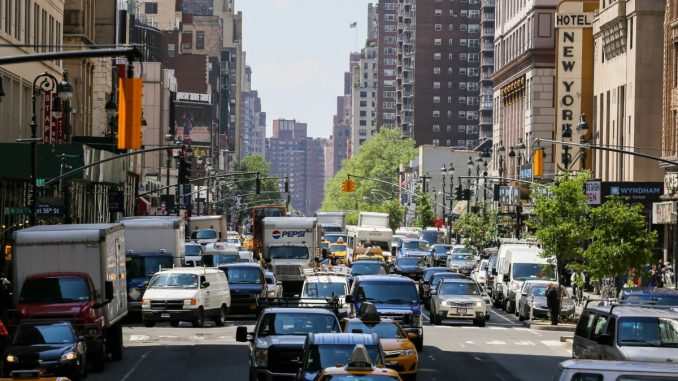
Congestion pricing launched in NYC on Jan. 5, 2025.
Photo via Getty Images
Nearly 300 FDNY Emergency Medical Service workers say they’re ready to leave Midtown and Lower Manhattan, citing the financial burden congestion pricing will put on their costs of living, their union announced ahead of the toll program’s Sunday start.
Like all NYC workers, members of FDNY Local 2507, representing the city’s 4,100 emergency medical technicians (EMTs) and paramedics, are not exempt from the MTA’s $9 base toll into Manhattan south of and including 60th Street. As a result, the union is urging its approximately 270 EMTs and paramedics assigned to the area to transfer out as soon as possible.
Oren Barzilay, president of Local 2507, said city EMTs and paramedics save thousands of lives each year despite earning less than most delivery workers across the city, thanks to a new city law.
In 2024, City Hall mandated a nearly $20 per hour minimum wage increase for app-based food delivery workers across the five boroughs. Meanwhile, FDNY EMTs continue to earn just $18.94 per hour of work, less than $3 over the city’s 2025 minimum wage.
“Our members have complained to us when this was first brought up a while back that they would simply resign or ask to be transferred because they couldn’t afford it at the time when it was $15 an hour,” Barzilay said. “Although it dropped to $9, that’s a $45 a week expense. When you’re making poverty wages, every dollar means a lot to our men and women.”
In addition to congestion pricing, inflation and other economic problems, Barzilay said the union has been without a contract for three years.
“So to add an additional expense just simply isn’t going to work. It doesn’t make any sense,” he said.
City workers are not exempt from congestion pricing, though authorized emergency and municipal-owned vehicles are not charged a toll for traveling into the Congestion Relief Zone. The MTA offers various exemptions and discounts based on income.
Local 2507 is not the only union that fought congestion pricing. The United Federation of Teachers and the Trucking Association of New York tried unsuccessfully to pause congestion pricing last month while their lawsuits opposing the program proceeded.
Many other municipal workers also consider bidding adieu to their Midtown or Lower Manhattan posts.
Brian Meyer is a court officer from Staten Island who drives into Midtown for work every day. He said he would likely now take the express bus to the court where he works, which would make his commute cheaper but at least 45 minutes longer.
“I already pay for the Verrazzano Bridge toll and the Hugh Carey Tunnel toll, and if I want to continue to drive to work, I’ll either have to pay the congestion fee or attempt to park above 60th Street and walk down,” said Meyer, who works on West 54th Street.
The tolls for many Staten Islanders driving into Manhattan can reach well into the hundreds each month now that congestion pricing is in effect.
“I and other Staten Islanders commuting into the congestion zone would be paying $500 to $600 a month in tolls just to get to and from work,” Meyer said.
As a result, the officer is highly considering a move out of Midtown.
“I‘m probably going to put in my transfer next week when I return to work,” he said.
Jennifer DiScalo Tricomi, another Staten Island resident, said her husband, who works for the NYC Department of Sanitation, is planning to transfer from his Manhattan post come April.
Meanwhile, the MTA celebrated the launch of congestion pricing by unveiling a sign informing drivers of the new toll at Broadway and West 62nd Street late Saturday night.

MTA Chair and CEO Janno Lieber joined politicians and members of transportation advocacy groups to mark the occasion.
“We’re doing something that proves the city is not paralyzed to deal with the challenges,” Lieber said. We’re doing something that’s about cleaner air and safer streets and less traffic and better transit. We’re doing something that’s historic. It’s the first in the nation.
Charles Frizziola, a retired firefighter in the Big Apple, shared his professional insight on the impact of congestion pricing on NYC and city jobs.
“I think a lot of senior personnel in all municipalities are going to transfer out of Downtown, leaving issues with junior personnel running the show,” the fireman said. “We’re talking about NYC.”

